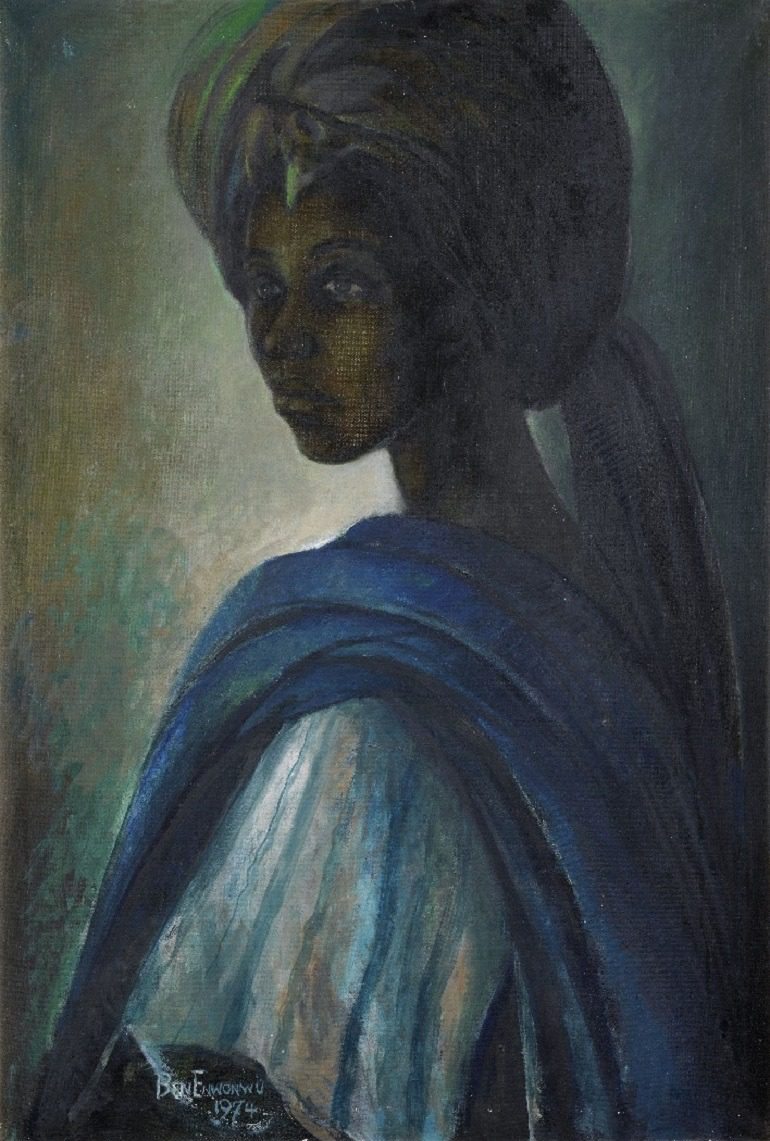ART AUCTION
Tutu, a recently discovered oil on canvas portrait by the celebrated Nigerian artist Ben Enwonwu sold for $1.6 million at the Africa Now Auction. Image: Bonhams
SOLD AT AUCTION
Ben Enwonwu’s Tutu, an oil on canvas portrait painting described as Africa’s Mona Lisa by prize-winning Nigerian novelist Ben Okri smashes world record at Bonhams Africa Now sale in London.
BY KAZAD
LONDON- Tutu, an oil on canvas painting by Ben Enwonwu has sold for $1,664,634 (£1,205,000) at Bonhams African Now auction in London, setting a new world record for the artist’s work at auction. Painted in 1974, the recently discovered painting is the portrait of the Ife royal princess Adetutu Ademiluyi. In the spring edition of Bonhams Magazine, Booker Prize-winning Nigerian novelist Ben Okri described the long-lost portrait of Tutu as Africa’s Mona Lisa.
Weeks before the portrait of Tutu went on auction at the Bonhams Africa Now sale in London, expectations were high that the painting would make auction record for the celebrated African artist, who has already shattered many records at auction. That expectation increased with every passing moment as the work came up for sale.
As the auction began, collectors who had been waiting for the moment could not hide their urge to add the painting to their collection. With every bid, offers increased. After a 20-minute bidding frenzy, the work sold to a bidder on the telephone. Estimated at £200,000-300,000, the painting sold for £1,205,000, shattering all expectations. The result makes Tutu the most valuable Modern Nigerian painting sold at auction.
Measuring 97 x 66.5cm, Tutu has great provenance and historical importance. Speaking about the portrait painting and sale, Bonham’s Director of Modern African Art, Giles Peppiatt was delighted by the interest showed by collectors during the sale of the painting. He said: “The portrait of Tutu is a national icon in Nigeria and of huge cultural significance. I am delighted that it generated so much interest and set a new world record for the artist. It is very exciting to have played a part in the discovery and sale of this remarkable work.”
The historical significance of the Tutu portrait sold during the African Now Auction in London cannot be overstated. After the Nigerian-Biafran conflict of the late 1960s, Nigerians struggled to find unity. The tribal civil war left many disillusioned about the future of their budding nation. When everything seemed to have failed, they found hope in the portrait of Tutu. The image became a symbol of national reconciliation for a country struggling for unity.
Ben Enwonwu: A Chance Encounter Between Artist and the Princess
Ben Enwonwu’s quest to paint the portrait of Adetutu began after a chance encounter in Ife. Enwonwu first encountered Adetutu during one of his numerous trips to the countryside surrounding Ife where he sketched the landscape and recorded cultural traditions and practices. Captivated by her beauty and regal splendor, Enwonwu knew he must record her gorgeousness on canvas for posterity. In addition to Adetutu’s beauty, Enwonwu may also have been motivated by her status as a royal princess of Ife. Being of royal lineage, descended from the Umuezearoli of Onitsha, himself, Enwonwu must have found it necessary to capture the royalty of another culture.
However, perhaps, the greatest reason for wanting to paint the portrait of the beautiful princess was strategic. The Biafran war engendered deep distrust among different Nigerian ethnic groups especially the Igbo and Yoruba. As an artist of Igbo ethnicity living in a Yoruba land, Enwonwu must have realized that winning the approval of the Ife royal house would offer him protection from any problems arising from his Igbo ethnicity, a contentious issue in post-war Nigeria.
Before embarking on painting the portrait of their beautiful daughter, Ben Enwonwu first had to get the consent of Adetutu’s parents. Although the Ife royal family was initially wary of Enwonwu’s overtures, they eventually gave their permission. Enwonwu executed three versions of Tutu between 1973-74. In these paintings, Enwonwu depicts Tutu in formal and informal Yoruba attire. He captures her youthful visage in a three-quarter view; her long neck is brought into sharp focus against the folds of woven cloth draped over her left shoulder. The well-articulated brushwork and diaphanous treatment of forms impart a haunting quality to her regal pose.
Enwonwu’s Tutu portraits explore a new concept of femininity and were very important to his development as an artist. They are the defining works of his postcolonial practice and late stylistic period. All three portraits of Tutu had been considered lost until Giles Peppiatt discovered the current picture in a London apartment, where it had hung for the past 30 years.
Writing on the amazing discovery of the painting, Ben Okri notes: “It amounts to the most significant discovery in contemporary African art in over fifty years. It is the only authentic Tutu, the equivalent of some rare archaeological find. It is a cause for celebration, a potentially transforming moment in the world of art.”
While the celebration continues about the discovery of the Tutu sold at the Bonhams African Now Auction, the principal painting in the series, Tutu (1973) is still missing. The portrait was Enwonwu’s most prized possession and remained in his studio until his death in 1994. Today, the painting’s whereabouts is a mystery and ownership hotly contested.
In addition to Tutu, Negritude also painted in the 1970s by Enwonwu, was sold for £100,000 in the same sale. To bring context to the auction, the sale was broadcast live to a Bonhams auction event in Lagos, where bidders were able to participate in real time.

